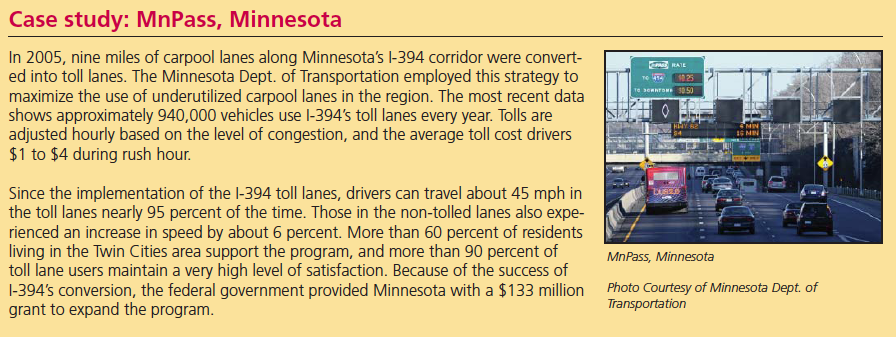ILLINOIS TOLLWAY
METROPOLITAN PLANNING COUNCIL
Stuck in Traffic; a costly problem
In 2008, the Metropolitan Planning Council’s Moving at the Speed of Congestion study found the region was losing at least $7.3 billion every year in wasted time, fuel, and environmental damages — enough money to fund a Red Line southern extension on the CTA, the Elgin-O’Hare and West O’Hare Bypass, a new West Loop Transportation Center, and new lanes on Interstate 80. MPC’s study also showed every driver spends an average of an extra two-and- a-half days stuck in traffic each year and the average “congestion tax” in the region is $1.58 per person.
Across the country, people are tired of wasting time and money, sitting behind the wheel with no real alternatives to driving. Recognizing the severity of the problem, the U.S. Dept. of Transportation’s Federal Highway Administration (FHWA) is funding projects to study the potential of new and innovative strategies to alleviate traffic congestion, improve the environment, and provide better mobility.
Congestion pricing is one of those strategies.
Figures and findings from Moving at the Speed of Congestion
- $7.3 billion
Cost of congestion to the Chicago region per year - 87,000
Number of jobs the region would add by eliminating excess congestion - 22%
Percent increase in peak travel time as a result of congested traffic conditions
What is Congestion Pricing?
CONGESTION PRICING, a form of transportation demand management, is an efficient and equitable way to re-balance traffic conditions on the road. Successful only if complemented with enhanced transit, it creates incentives for people to travel during less congested times, encourages the use of carpooling and transit, and reduces the enormous waste resulting from traffi c congestion. Congestion pricing has helped several U.S. and international cities address pressing mobility concerns and generate clean, healthy, and financially sustainable ways for people to get where they need to go. With a congestion pricing system in place to allow traffic to flow more efficiently, if only 5 percent of drivers change their travel behavior by either shifting mode or time of day, many more cars would be able to move through the same exact physical space in less time. In other words, congestion pricing delays the “tipping point” at which traffi c gridlock becomes unbearable.
Congestion pricing is not a new concept. Flights during Thanksgiving weekend are more expensive than flights in October. Movie theaters charge more on a Friday night than on a Tuesday afternoon. Cell phone providers often give discounts during weeknights or on weekends. Electricity providers charge higher prices during peak periods like weekday afternoons, than weekend evenings. All of these are examples of managing demand. When traffi c is at its worst, people need reliable choices.
Types of congestion pricing
Congestion pricing is not one size-fits-all. Cities around the world have used different congestion pricing techniques to better manage their traffic flow. For example, with CORDON PRICING, as in Stockholm and London, tolls are charged to enter a city center. With VARIABLE PRICING, as in Lee County, Fla., tolls vary by congestion. In systems with FIXED PRICING, tolls vary by time of day. Based on initial outreach around the Chicago region, the study team determined a “fixed” model would be most appropriate here.
Download full report (PDF): The Road Less Traveled
About Illinois Tollway
www.illinoistollway.com
“The Illinois State Toll Highway Authority is dedicated to providing and promoting a safe and efficient system of toll supported highways while ensuring the highest possible level of service to our customers.”
About Metropolitan Planning Council
www.metroplanning.org
“Since 1934, the Metropolitan Planning Council (MPC) has been dedicated to shaping a more sustainable and prosperous greater Chicago region. As an independent, nonprofi t, nonpartisan organization, MPC serves communities and residents by developing, promoting and implementing solutions for sound regional growth.”
Tags: Chicago, Chicagoland, Congestion Pricing, IL, Illinois, Illinois Tollway, Metropolitan Planning Council, MPC, Wilbur Smith Associates







 RSS Feed
RSS Feed